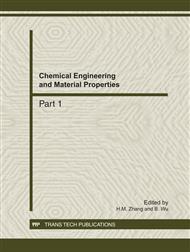p.1278
p.1283
p.1287
p.1291
p.1296
p.1302
p.1306
p.1311
p.1315
Direct Synthesis of 3,5-Dinitropyrazole Catalyzed by Newly Sulfated Nanosolid Superacid TiO2/ SO
Abstract:
The newly sulfated nanosolid superacid TiO2/SO4 prepared by sol-gel method was broadly characterized by acid base titration, XRD and TEM, which identified that the superfine solid TiO2/SO4 showing good dispersibility with average size of 27 nm belongs to kind of crystalline nanoparticles. With the help of the catalyst TiO2/SO4, the optimal reaction condition for direct transformation of pyrazole and nitrosonitric acid into 3, 5-Dinitropyrazole was n (pyrazol)=0.10 mol, m (TiO2/SO4 )=1.5g, V(n-octannol)=90mL, and V(nitrosonitric acid)=50mL. Moreover, the optimal yield of the catalytic reaction reached up to 59.4% when the reaction time is 7 hours. The nanosolid superacid catalyst is still of high activity after regenerating eight times by calcination at 600。C.
Info:
Periodical:
Pages:
1296-1301
Citation:
Online since:
December 2011
Authors:
Keywords:
Price:
Сopyright:
© 2012 Trans Tech Publications Ltd. All Rights Reserved
Share:
Citation:


